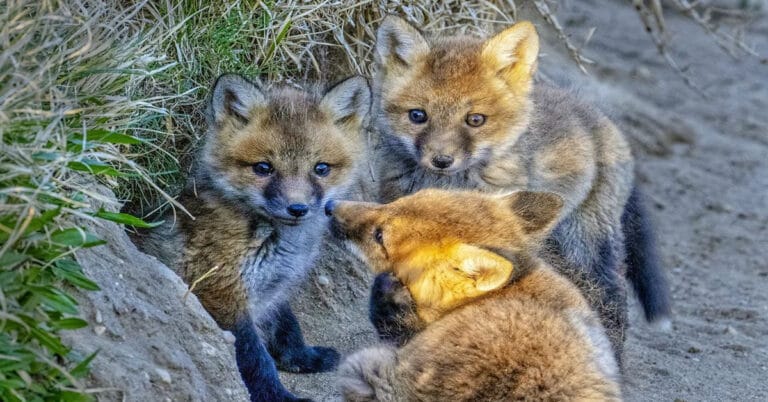Fox Den – Usage & Ways to Identify
Foxes are amazing animals, not only because of their appearance and visual characteristics but also because of their behavioral patterns. They are considered to be very smart animals that can withstand and overcome any kind of difficulty. Foxes managed to learn survival in extreme climates and urban environments.
Have you ever wondered where the foxes live? Well, they live in a den. Fox dens are truly something spectacular. Fox dens are also known in England as earth or burrows. The effort that is put into the building process and the results that are received are wonderful. So let’s “dig in” and learn more about the fox den.
Habitat Preferences
Fox dens can be found in many different areas. Generally, they are built on sites with heavy vegetation, tall grass, under buildings, or even under big rocks. Foxes prefer the well-drained grounds. They often dug burrows near the water, whether on a hill or a slope. This kind of place tends to have good drainage. The best for them is soil that is loose and easy to dig. Depending on the species, the preferences of fox den locations change.
Other than the places mentioned above, regular foxes often choose meadows and pine forests. Because of their adaptable nature, they can tolerate human disturbance at a high level. As a result of this, more and more fox dens are found near urban areas.
Fox dens that are built between the tree roots can last as long as decades. However, the ones that are made in the steppes can only be used for several years. Sources state that some of the dens that were discovered in Europe were hundreds of years old. Arctic dens can also last a long time. For example, arctic dens can be as old as 100–200 years old. Some dens also had up to 180 entrances.
How Often Are Fox Dens Used?
Fox dens can often be empty for months. The reason for this could vary and is dependent on many factors, including the season, area, and habitats. Most of the time, fox dens are only used during the cubs’ rearing. The dens are mostly used by female foxes (vixens), but there have been a few cases of males using them. Mothers usually tend their kits there, and the male fox only gets to see the babies for the first time after they leave the den.
The amount of food that is stored in the den by the foxes depends on how many individuals are in the family. They mainly store the food in large quantities and do so to get through the winter and spring seasons. Foxes do not hunt every day. So, the main food that is stored is meat. berries, fruit, and vegetables. They start eating with the meat that they brought first, so this way, it will not go bad.
Mostly, the fox den has been used for an average of four months a year. Foxes tend to prefer to live and lay around in tall vegetation. However, another main factor that determines how often the fox dens are used is the weather. For example, Fennec foxes use the dens not only for raising their kits but also to hide from the extremely hot temperatures outside. Also, Arctic foxes are more likely to use the fox den longer because they escape the freezing temperatures and climate.
The Layout Of The Fox Den
Fox dens are tunnels that are dug, whether under a tree, under a large rock, or in the shrubs. The average fox den consists of 4 or 5 sections at least. Sections generally include the entrance, the ramp, the main den, and several rooms that are used to store the food. However, the fox den can be pretty big in size and usually depends on the size of the pack.
The entrance ramp of the fox den is like a corridor for the whole structure. This corridor can be an average of 3 to 8 feet deep in the ground. The ramp is located between the entrance and the main den.
Sometimes, already existing dens are expanded, and new entrances or rooms are also added. The length of the burrow itself can be as long as 80 feet. Large dens can have 3 to 8 entrances, or even more. They come with multiple dugout areas. An interesting fact is that each of those areas has a specific function.
Smaller-sized dens have only one or two entrances and are approximately 3 feet deep. They may also have additional rooms that can be ten to twenty feet deep. Each entry can be up to 8 inches in diameter.
However, the fennec fox den is truly an exceptional case. These particular ones are pretty complex and can have up to 15 entrances and very long tunnels. It does not matter how complex the fox den structure is. The main things and essential components remain the same.
How Can Fox Den Be Identified?
It is pretty difficult to find and identify fox dens. Foxes are very clever, and they can hide spots so well that they can be impossible to spot. Fox dens can be identified by several factors. First is the hole size. The average entrance holes are at least 4 inches in diameter and large enough to fit a fox.
Foxes are surplus hunters. They tend to save and hide the leftover food. Also, the food traces that they brought to the den can be found; these will lead to the hole. Unlike many other mammals, such as badgers, they leave the pieces of their prey and meals around the dens and do not clean them.
Normally, foxes move around and live in the area where their den is located, so the latrine areas can be close to it. Normally, foxes mark their territory with urine, and because of that, the area can have a distinct smell. Which, eventually, is the sign that the fox den is somewhere close.
If there is enough food and the area is suitable for foxes, there can be 2 or 3 dens found within the 10 square miles. If resources are limited, the fox dens are reduced to one per 20 square miles.
In spring, the foxes find a return to the dens and clean them from excess soil that was collected by rapid movements. To do so, they start with their forepaws and, with the kicking motions of their legs, throw the soil out of the burrow. People have often seen kits playing on the trampled debris that was created during the cleaning process.
Usage of the Dens
Foxes often have several dens. Generally, they have one main den, Natal, and also a backup den. They are frequently observed stealing burrows from other animals and making them their homes. An interesting fact is that foxes sometimes inherit the dens from their parents, and some burrows can also be used by different generations.
If the fox den is in a safe location, chances are that they will come back to it every year as many times as they can. Normally, they do not abandon their dens if they do not have to and if there are no threats. Most of the time, they are left because of the low amount of food, predators, or human influences. Another major reason for den abandonment is the spread of disease, and this is kind of a defense mechanism against it.
Mother fox either goes back to the den left by other foxes and animals or builds one on her own. Vixens do this before the babies are born. Kits do not leave the burrow until they reach the age of 4 to 5 weeks. After they develop some senses like hearing, vision, and smell, they start to exit from the underground home.
During the process, the mother fox teaches them how to get out by leaving the food closer and closer to the entrance. After they realize where the entrance is, the vixens leave the food outside the den. Kits move out of the den when they reach the age of 3 to 4 months.
If the situation is critical, foxes can even share their dens with other animals such as rabbits, wolves, porcupines, gerbils, and other woodland creatures. Before they feel safe, they cohabitate carefully with them. However, after all, they are animals, and eventually, the strongest stays in the den. If the dens do not fit the “standards” of the foxes, they do not have a problem fixing them and remodeling them however they want.
Bottom Line
Every creature on earth has a “home” – a place where they feel safe, give birth to their babies, and raise them. Such a place has to be hidden from predators and also protect mammals from outer threats. Different animals have different methods of making their homes. For example, some very famous types of living places are burrows, nests, holes, caves, grassland, and others. Foxes live in dens that are either built by them or borrowed from other mammals.
There is no specific rule about where the foxes build their dens. In general, they prefer the grasslands, dense forests, or the tundra. Foxes mainly use the dens to store their food and raise their babies. Dens help them to hide from predators and also keep them safe in extreme climates.

Nato is a content writer and researcher with a background in psychology who’s eager to explore the wonders of nature. As a travel enthusiast and animal lover, she hopes to inspire others to discover and cherish the beauty and importance of the natural world.







